Critical Literature Review: Role of Environmental Project Management
VerifiedAdded on 2023/06/10
|10
|2712
|162
Report
AI Summary
This literature review critically examines the role of environmental project management within the construction industry. It begins by introducing the importance of innovation and the impact of environmental project management, followed by an analysis of theoretical perspectives, including the strategic environmental management system and the influence of stakeholders. The review explores the benefits of environmental project management, such as hazard reduction and waste disposal, alongside the implementation of environmental project management systems, including steps for preparation, remediation, and employee training. It identifies significant environmental aspects, risk assessment and hazard identification, and methods for reducing environmental risks. The review also discusses the ISO 14001 certification and its role in environmental management within the construction sector. The review concludes with an overview of performance indicators and economic factors relevant to the construction industry.
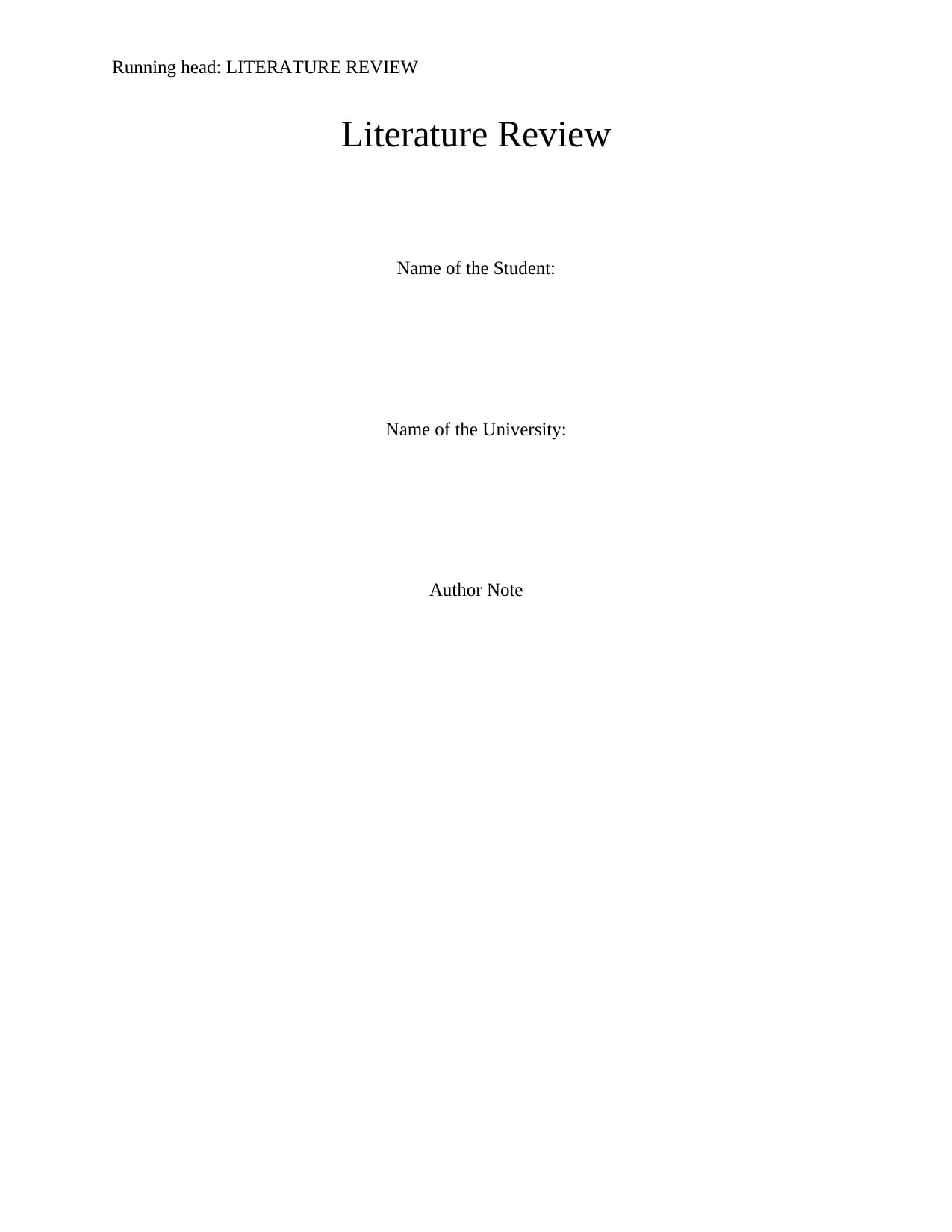
Running head: LITERATURE REVIEW
Literature Review
Name of the Student:
Name of the University:
Author Note
Literature Review
Name of the Student:
Name of the University:
Author Note
Paraphrase This Document
Need a fresh take? Get an instant paraphrase of this document with our AI Paraphraser
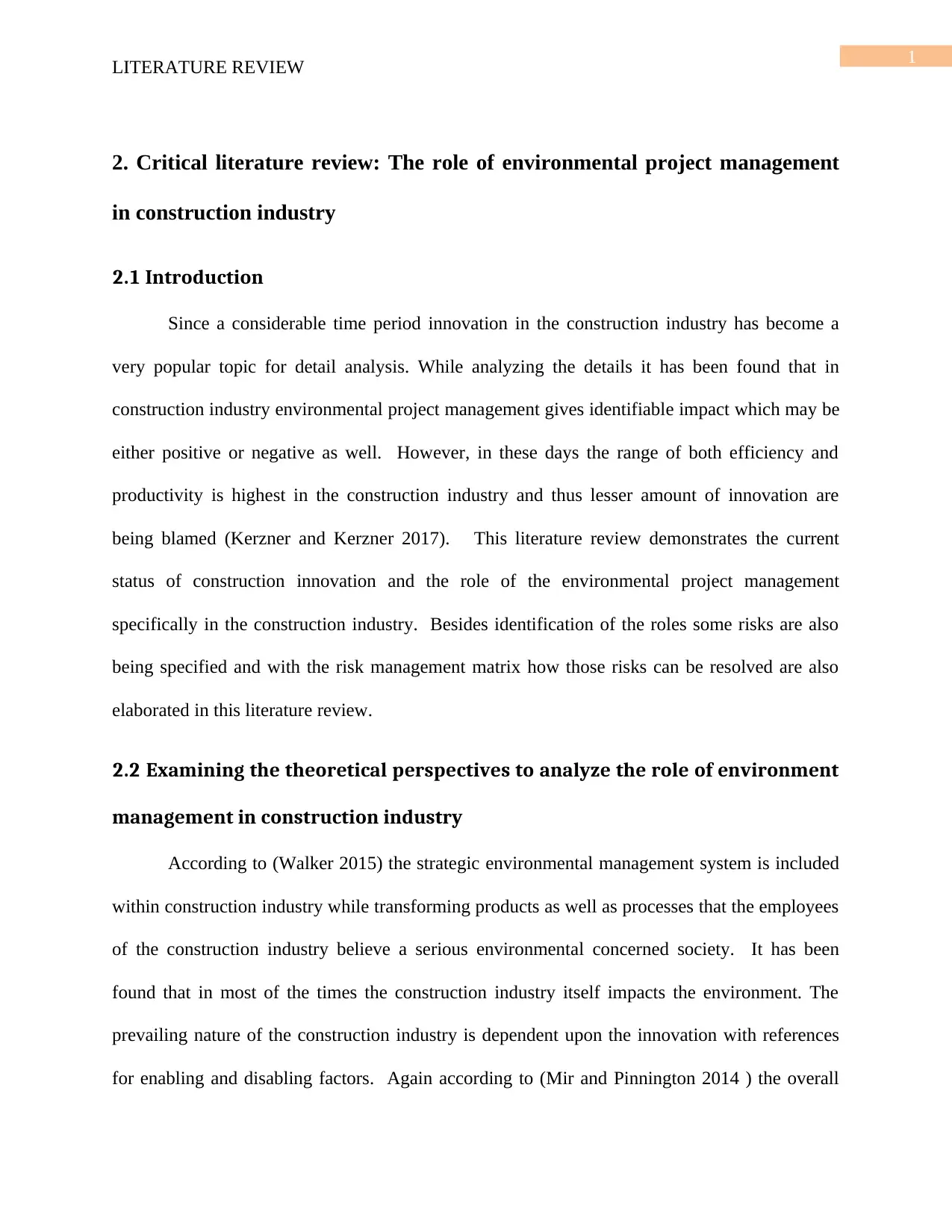
1
LITERATURE REVIEW
2. Critical literature review: The role of environmental project management
in construction industry
2.1 Introduction
Since a considerable time period innovation in the construction industry has become a
very popular topic for detail analysis. While analyzing the details it has been found that in
construction industry environmental project management gives identifiable impact which may be
either positive or negative as well. However, in these days the range of both efficiency and
productivity is highest in the construction industry and thus lesser amount of innovation are
being blamed (Kerzner and Kerzner 2017). This literature review demonstrates the current
status of construction innovation and the role of the environmental project management
specifically in the construction industry. Besides identification of the roles some risks are also
being specified and with the risk management matrix how those risks can be resolved are also
elaborated in this literature review.
2.2 Examining the theoretical perspectives to analyze the role of environment
management in construction industry
According to (Walker 2015) the strategic environmental management system is included
within construction industry while transforming products as well as processes that the employees
of the construction industry believe a serious environmental concerned society. It has been
found that in most of the times the construction industry itself impacts the environment. The
prevailing nature of the construction industry is dependent upon the innovation with references
for enabling and disabling factors. Again according to (Mir and Pinnington 2014 ) the overall
LITERATURE REVIEW
2. Critical literature review: The role of environmental project management
in construction industry
2.1 Introduction
Since a considerable time period innovation in the construction industry has become a
very popular topic for detail analysis. While analyzing the details it has been found that in
construction industry environmental project management gives identifiable impact which may be
either positive or negative as well. However, in these days the range of both efficiency and
productivity is highest in the construction industry and thus lesser amount of innovation are
being blamed (Kerzner and Kerzner 2017). This literature review demonstrates the current
status of construction innovation and the role of the environmental project management
specifically in the construction industry. Besides identification of the roles some risks are also
being specified and with the risk management matrix how those risks can be resolved are also
elaborated in this literature review.
2.2 Examining the theoretical perspectives to analyze the role of environment
management in construction industry
According to (Walker 2015) the strategic environmental management system is included
within construction industry while transforming products as well as processes that the employees
of the construction industry believe a serious environmental concerned society. It has been
found that in most of the times the construction industry itself impacts the environment. The
prevailing nature of the construction industry is dependent upon the innovation with references
for enabling and disabling factors. Again according to (Mir and Pinnington 2014 ) the overall
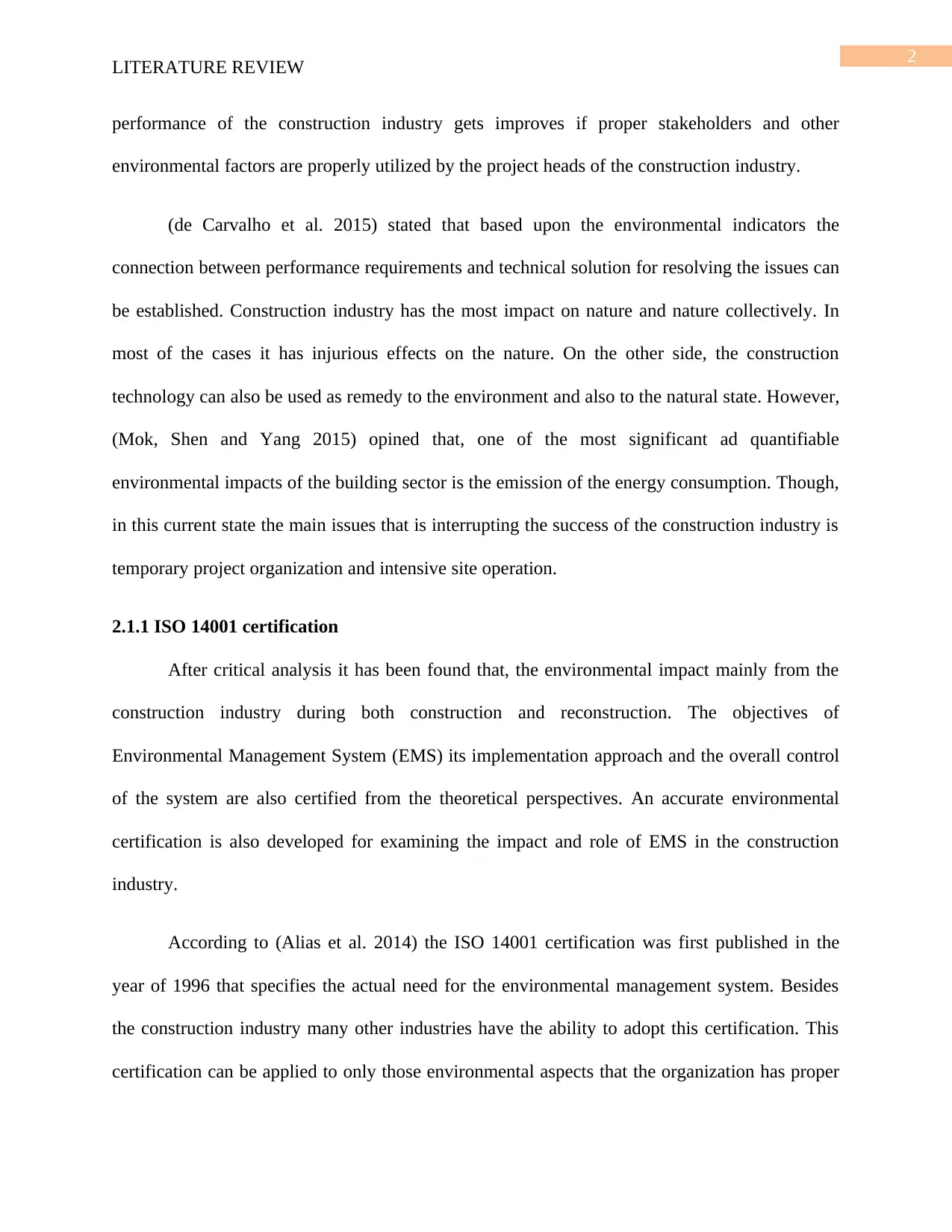
2
LITERATURE REVIEW
performance of the construction industry gets improves if proper stakeholders and other
environmental factors are properly utilized by the project heads of the construction industry.
(de Carvalho et al. 2015) stated that based upon the environmental indicators the
connection between performance requirements and technical solution for resolving the issues can
be established. Construction industry has the most impact on nature and nature collectively. In
most of the cases it has injurious effects on the nature. On the other side, the construction
technology can also be used as remedy to the environment and also to the natural state. However,
(Mok, Shen and Yang 2015) opined that, one of the most significant ad quantifiable
environmental impacts of the building sector is the emission of the energy consumption. Though,
in this current state the main issues that is interrupting the success of the construction industry is
temporary project organization and intensive site operation.
2.1.1 ISO 14001 certification
After critical analysis it has been found that, the environmental impact mainly from the
construction industry during both construction and reconstruction. The objectives of
Environmental Management System (EMS) its implementation approach and the overall control
of the system are also certified from the theoretical perspectives. An accurate environmental
certification is also developed for examining the impact and role of EMS in the construction
industry.
According to (Alias et al. 2014) the ISO 14001 certification was first published in the
year of 1996 that specifies the actual need for the environmental management system. Besides
the construction industry many other industries have the ability to adopt this certification. This
certification can be applied to only those environmental aspects that the organization has proper
LITERATURE REVIEW
performance of the construction industry gets improves if proper stakeholders and other
environmental factors are properly utilized by the project heads of the construction industry.
(de Carvalho et al. 2015) stated that based upon the environmental indicators the
connection between performance requirements and technical solution for resolving the issues can
be established. Construction industry has the most impact on nature and nature collectively. In
most of the cases it has injurious effects on the nature. On the other side, the construction
technology can also be used as remedy to the environment and also to the natural state. However,
(Mok, Shen and Yang 2015) opined that, one of the most significant ad quantifiable
environmental impacts of the building sector is the emission of the energy consumption. Though,
in this current state the main issues that is interrupting the success of the construction industry is
temporary project organization and intensive site operation.
2.1.1 ISO 14001 certification
After critical analysis it has been found that, the environmental impact mainly from the
construction industry during both construction and reconstruction. The objectives of
Environmental Management System (EMS) its implementation approach and the overall control
of the system are also certified from the theoretical perspectives. An accurate environmental
certification is also developed for examining the impact and role of EMS in the construction
industry.
According to (Alias et al. 2014) the ISO 14001 certification was first published in the
year of 1996 that specifies the actual need for the environmental management system. Besides
the construction industry many other industries have the ability to adopt this certification. This
certification can be applied to only those environmental aspects that the organization has proper
⊘ This is a preview!⊘
Do you want full access?
Subscribe today to unlock all pages.

Trusted by 1+ million students worldwide
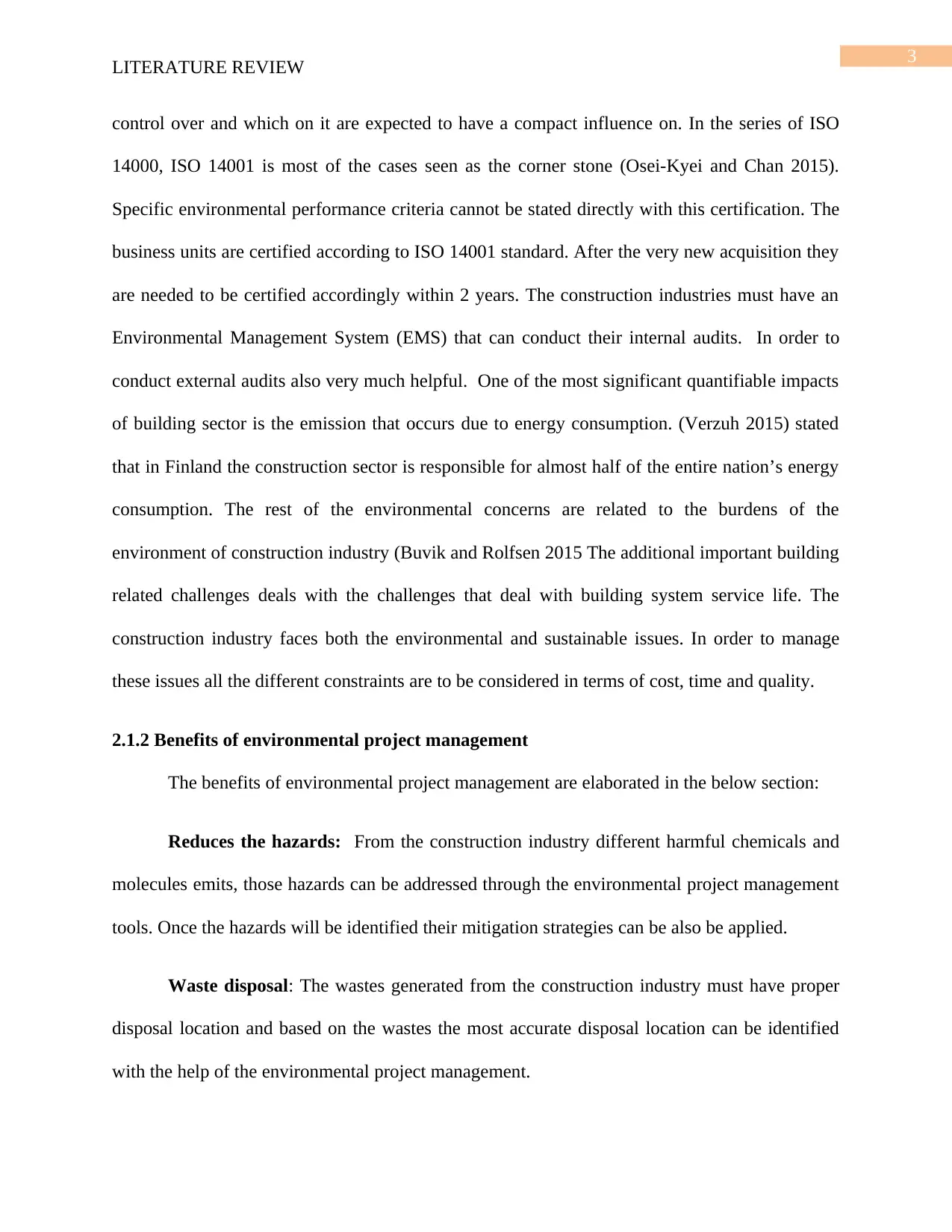
3
LITERATURE REVIEW
control over and which on it are expected to have a compact influence on. In the series of ISO
14000, ISO 14001 is most of the cases seen as the corner stone (Osei-Kyei and Chan 2015).
Specific environmental performance criteria cannot be stated directly with this certification. The
business units are certified according to ISO 14001 standard. After the very new acquisition they
are needed to be certified accordingly within 2 years. The construction industries must have an
Environmental Management System (EMS) that can conduct their internal audits. In order to
conduct external audits also very much helpful. One of the most significant quantifiable impacts
of building sector is the emission that occurs due to energy consumption. (Verzuh 2015) stated
that in Finland the construction sector is responsible for almost half of the entire nation’s energy
consumption. The rest of the environmental concerns are related to the burdens of the
environment of construction industry (Buvik and Rolfsen 2015 The additional important building
related challenges deals with the challenges that deal with building system service life. The
construction industry faces both the environmental and sustainable issues. In order to manage
these issues all the different constraints are to be considered in terms of cost, time and quality.
2.1.2 Benefits of environmental project management
The benefits of environmental project management are elaborated in the below section:
Reduces the hazards: From the construction industry different harmful chemicals and
molecules emits, those hazards can be addressed through the environmental project management
tools. Once the hazards will be identified their mitigation strategies can be also be applied.
Waste disposal: The wastes generated from the construction industry must have proper
disposal location and based on the wastes the most accurate disposal location can be identified
with the help of the environmental project management.
LITERATURE REVIEW
control over and which on it are expected to have a compact influence on. In the series of ISO
14000, ISO 14001 is most of the cases seen as the corner stone (Osei-Kyei and Chan 2015).
Specific environmental performance criteria cannot be stated directly with this certification. The
business units are certified according to ISO 14001 standard. After the very new acquisition they
are needed to be certified accordingly within 2 years. The construction industries must have an
Environmental Management System (EMS) that can conduct their internal audits. In order to
conduct external audits also very much helpful. One of the most significant quantifiable impacts
of building sector is the emission that occurs due to energy consumption. (Verzuh 2015) stated
that in Finland the construction sector is responsible for almost half of the entire nation’s energy
consumption. The rest of the environmental concerns are related to the burdens of the
environment of construction industry (Buvik and Rolfsen 2015 The additional important building
related challenges deals with the challenges that deal with building system service life. The
construction industry faces both the environmental and sustainable issues. In order to manage
these issues all the different constraints are to be considered in terms of cost, time and quality.
2.1.2 Benefits of environmental project management
The benefits of environmental project management are elaborated in the below section:
Reduces the hazards: From the construction industry different harmful chemicals and
molecules emits, those hazards can be addressed through the environmental project management
tools. Once the hazards will be identified their mitigation strategies can be also be applied.
Waste disposal: The wastes generated from the construction industry must have proper
disposal location and based on the wastes the most accurate disposal location can be identified
with the help of the environmental project management.
Paraphrase This Document
Need a fresh take? Get an instant paraphrase of this document with our AI Paraphraser
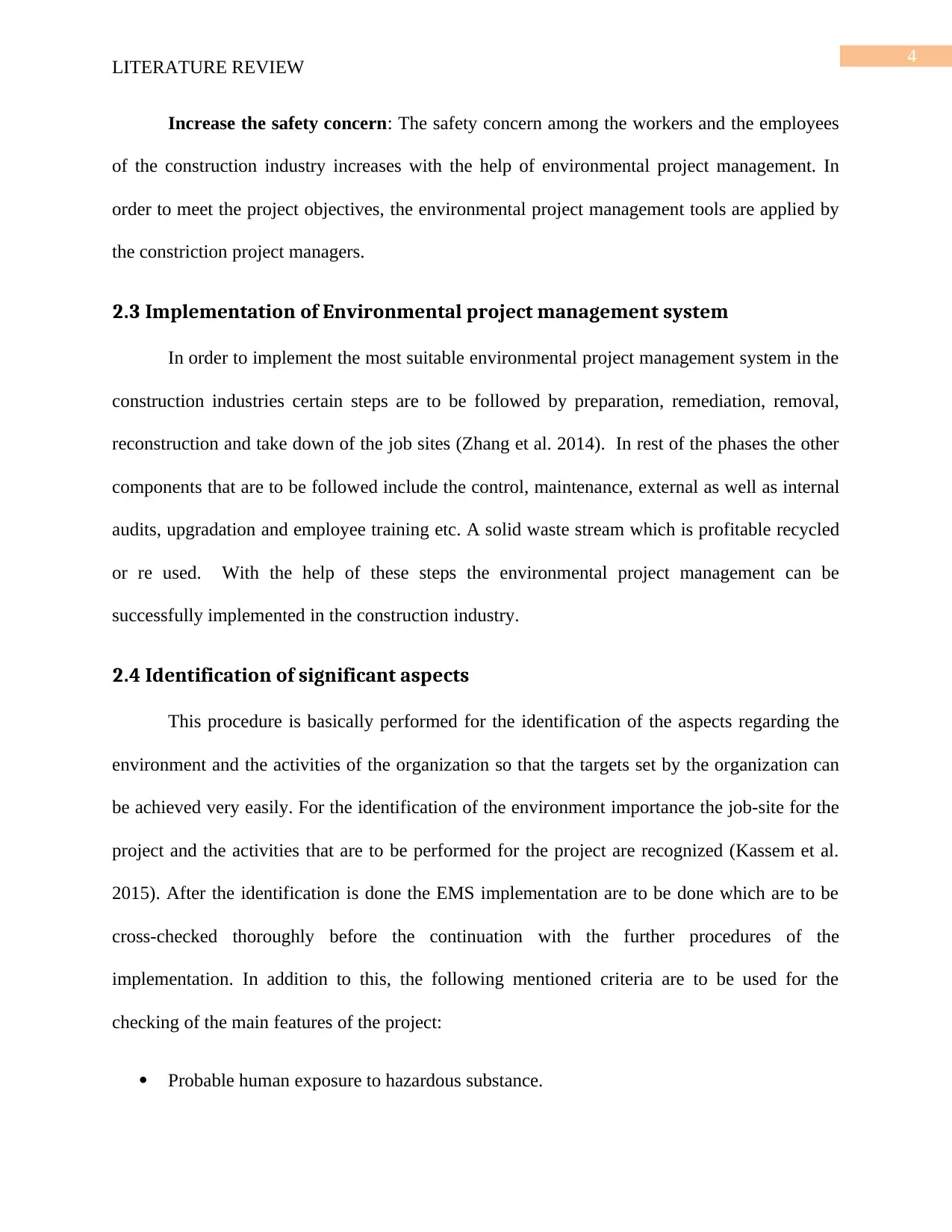
4
LITERATURE REVIEW
Increase the safety concern: The safety concern among the workers and the employees
of the construction industry increases with the help of environmental project management. In
order to meet the project objectives, the environmental project management tools are applied by
the constriction project managers.
2.3 Implementation of Environmental project management system
In order to implement the most suitable environmental project management system in the
construction industries certain steps are to be followed by preparation, remediation, removal,
reconstruction and take down of the job sites (Zhang et al. 2014). In rest of the phases the other
components that are to be followed include the control, maintenance, external as well as internal
audits, upgradation and employee training etc. A solid waste stream which is profitable recycled
or re used. With the help of these steps the environmental project management can be
successfully implemented in the construction industry.
2.4 Identification of significant aspects
This procedure is basically performed for the identification of the aspects regarding the
environment and the activities of the organization so that the targets set by the organization can
be achieved very easily. For the identification of the environment importance the job-site for the
project and the activities that are to be performed for the project are recognized (Kassem et al.
2015). After the identification is done the EMS implementation are to be done which are to be
cross-checked thoroughly before the continuation with the further procedures of the
implementation. In addition to this, the following mentioned criteria are to be used for the
checking of the main features of the project:
Probable human exposure to hazardous substance.
LITERATURE REVIEW
Increase the safety concern: The safety concern among the workers and the employees
of the construction industry increases with the help of environmental project management. In
order to meet the project objectives, the environmental project management tools are applied by
the constriction project managers.
2.3 Implementation of Environmental project management system
In order to implement the most suitable environmental project management system in the
construction industries certain steps are to be followed by preparation, remediation, removal,
reconstruction and take down of the job sites (Zhang et al. 2014). In rest of the phases the other
components that are to be followed include the control, maintenance, external as well as internal
audits, upgradation and employee training etc. A solid waste stream which is profitable recycled
or re used. With the help of these steps the environmental project management can be
successfully implemented in the construction industry.
2.4 Identification of significant aspects
This procedure is basically performed for the identification of the aspects regarding the
environment and the activities of the organization so that the targets set by the organization can
be achieved very easily. For the identification of the environment importance the job-site for the
project and the activities that are to be performed for the project are recognized (Kassem et al.
2015). After the identification is done the EMS implementation are to be done which are to be
cross-checked thoroughly before the continuation with the further procedures of the
implementation. In addition to this, the following mentioned criteria are to be used for the
checking of the main features of the project:
Probable human exposure to hazardous substance.
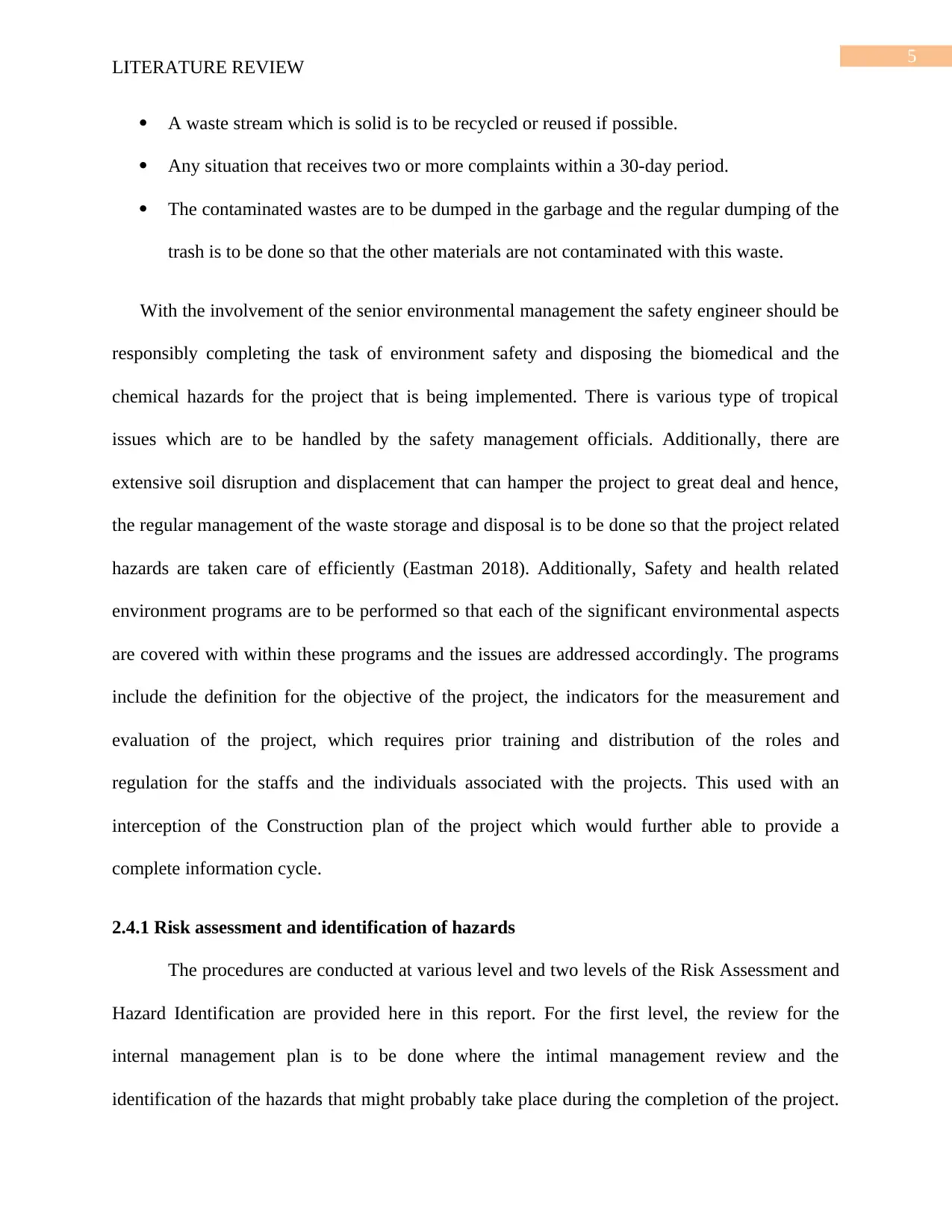
5
LITERATURE REVIEW
A waste stream which is solid is to be recycled or reused if possible.
Any situation that receives two or more complaints within a 30-day period.
The contaminated wastes are to be dumped in the garbage and the regular dumping of the
trash is to be done so that the other materials are not contaminated with this waste.
With the involvement of the senior environmental management the safety engineer should be
responsibly completing the task of environment safety and disposing the biomedical and the
chemical hazards for the project that is being implemented. There is various type of tropical
issues which are to be handled by the safety management officials. Additionally, there are
extensive soil disruption and displacement that can hamper the project to great deal and hence,
the regular management of the waste storage and disposal is to be done so that the project related
hazards are taken care of efficiently (Eastman 2018). Additionally, Safety and health related
environment programs are to be performed so that each of the significant environmental aspects
are covered with within these programs and the issues are addressed accordingly. The programs
include the definition for the objective of the project, the indicators for the measurement and
evaluation of the project, which requires prior training and distribution of the roles and
regulation for the staffs and the individuals associated with the projects. This used with an
interception of the Construction plan of the project which would further able to provide a
complete information cycle.
2.4.1 Risk assessment and identification of hazards
The procedures are conducted at various level and two levels of the Risk Assessment and
Hazard Identification are provided here in this report. For the first level, the review for the
internal management plan is to be done where the intimal management review and the
identification of the hazards that might probably take place during the completion of the project.
LITERATURE REVIEW
A waste stream which is solid is to be recycled or reused if possible.
Any situation that receives two or more complaints within a 30-day period.
The contaminated wastes are to be dumped in the garbage and the regular dumping of the
trash is to be done so that the other materials are not contaminated with this waste.
With the involvement of the senior environmental management the safety engineer should be
responsibly completing the task of environment safety and disposing the biomedical and the
chemical hazards for the project that is being implemented. There is various type of tropical
issues which are to be handled by the safety management officials. Additionally, there are
extensive soil disruption and displacement that can hamper the project to great deal and hence,
the regular management of the waste storage and disposal is to be done so that the project related
hazards are taken care of efficiently (Eastman 2018). Additionally, Safety and health related
environment programs are to be performed so that each of the significant environmental aspects
are covered with within these programs and the issues are addressed accordingly. The programs
include the definition for the objective of the project, the indicators for the measurement and
evaluation of the project, which requires prior training and distribution of the roles and
regulation for the staffs and the individuals associated with the projects. This used with an
interception of the Construction plan of the project which would further able to provide a
complete information cycle.
2.4.1 Risk assessment and identification of hazards
The procedures are conducted at various level and two levels of the Risk Assessment and
Hazard Identification are provided here in this report. For the first level, the review for the
internal management plan is to be done where the intimal management review and the
identification of the hazards that might probably take place during the completion of the project.
⊘ This is a preview!⊘
Do you want full access?
Subscribe today to unlock all pages.

Trusted by 1+ million students worldwide
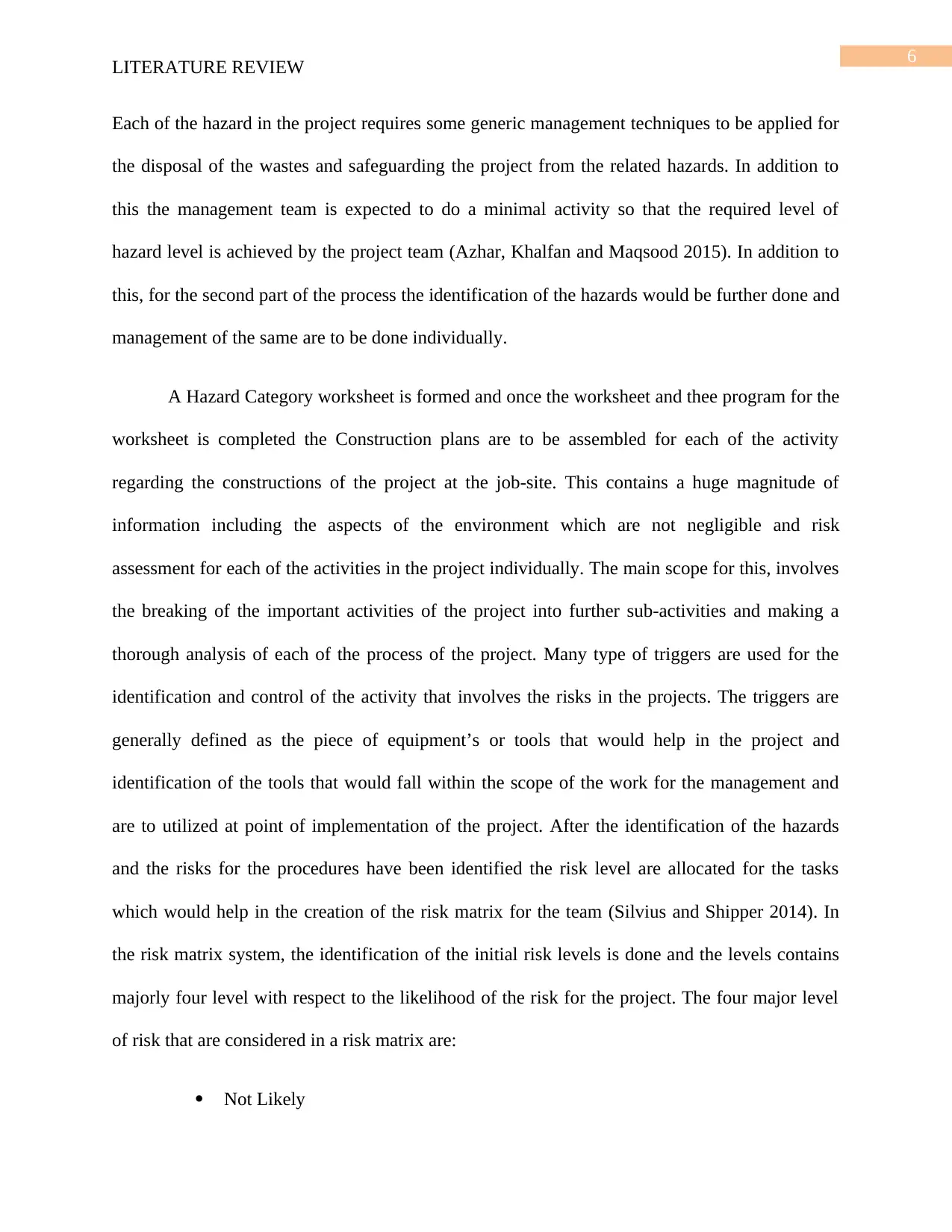
6
LITERATURE REVIEW
Each of the hazard in the project requires some generic management techniques to be applied for
the disposal of the wastes and safeguarding the project from the related hazards. In addition to
this the management team is expected to do a minimal activity so that the required level of
hazard level is achieved by the project team (Azhar, Khalfan and Maqsood 2015). In addition to
this, for the second part of the process the identification of the hazards would be further done and
management of the same are to be done individually.
A Hazard Category worksheet is formed and once the worksheet and thee program for the
worksheet is completed the Construction plans are to be assembled for each of the activity
regarding the constructions of the project at the job-site. This contains a huge magnitude of
information including the aspects of the environment which are not negligible and risk
assessment for each of the activities in the project individually. The main scope for this, involves
the breaking of the important activities of the project into further sub-activities and making a
thorough analysis of each of the process of the project. Many type of triggers are used for the
identification and control of the activity that involves the risks in the projects. The triggers are
generally defined as the piece of equipment’s or tools that would help in the project and
identification of the tools that would fall within the scope of the work for the management and
are to utilized at point of implementation of the project. After the identification of the hazards
and the risks for the procedures have been identified the risk level are allocated for the tasks
which would help in the creation of the risk matrix for the team (Silvius and Shipper 2014). In
the risk matrix system, the identification of the initial risk levels is done and the levels contains
majorly four level with respect to the likelihood of the risk for the project. The four major level
of risk that are considered in a risk matrix are:
Not Likely
LITERATURE REVIEW
Each of the hazard in the project requires some generic management techniques to be applied for
the disposal of the wastes and safeguarding the project from the related hazards. In addition to
this the management team is expected to do a minimal activity so that the required level of
hazard level is achieved by the project team (Azhar, Khalfan and Maqsood 2015). In addition to
this, for the second part of the process the identification of the hazards would be further done and
management of the same are to be done individually.
A Hazard Category worksheet is formed and once the worksheet and thee program for the
worksheet is completed the Construction plans are to be assembled for each of the activity
regarding the constructions of the project at the job-site. This contains a huge magnitude of
information including the aspects of the environment which are not negligible and risk
assessment for each of the activities in the project individually. The main scope for this, involves
the breaking of the important activities of the project into further sub-activities and making a
thorough analysis of each of the process of the project. Many type of triggers are used for the
identification and control of the activity that involves the risks in the projects. The triggers are
generally defined as the piece of equipment’s or tools that would help in the project and
identification of the tools that would fall within the scope of the work for the management and
are to utilized at point of implementation of the project. After the identification of the hazards
and the risks for the procedures have been identified the risk level are allocated for the tasks
which would help in the creation of the risk matrix for the team (Silvius and Shipper 2014). In
the risk matrix system, the identification of the initial risk levels is done and the levels contains
majorly four level with respect to the likelihood of the risk for the project. The four major level
of risk that are considered in a risk matrix are:
Not Likely
Paraphrase This Document
Need a fresh take? Get an instant paraphrase of this document with our AI Paraphraser
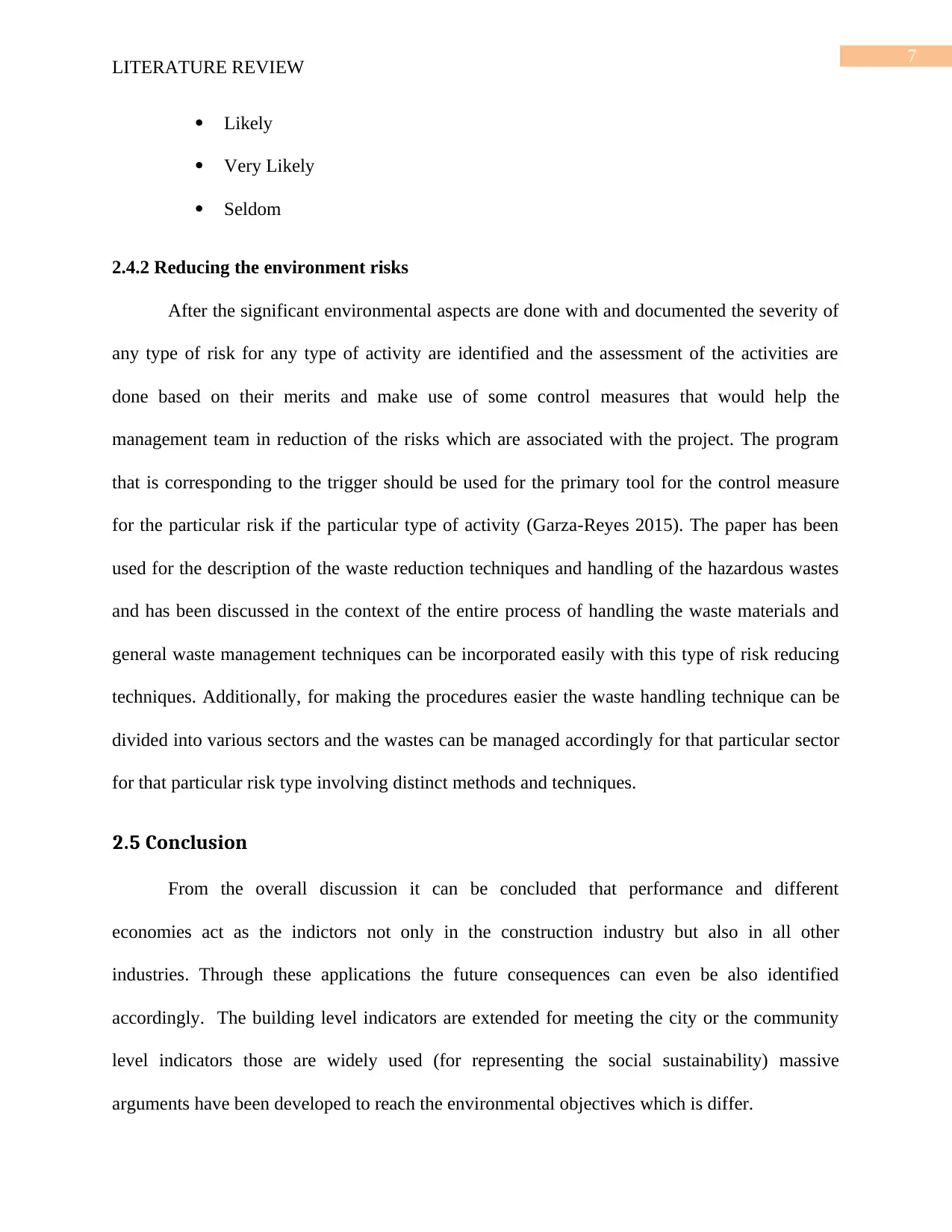
7
LITERATURE REVIEW
Likely
Very Likely
Seldom
2.4.2 Reducing the environment risks
After the significant environmental aspects are done with and documented the severity of
any type of risk for any type of activity are identified and the assessment of the activities are
done based on their merits and make use of some control measures that would help the
management team in reduction of the risks which are associated with the project. The program
that is corresponding to the trigger should be used for the primary tool for the control measure
for the particular risk if the particular type of activity (Garza-Reyes 2015). The paper has been
used for the description of the waste reduction techniques and handling of the hazardous wastes
and has been discussed in the context of the entire process of handling the waste materials and
general waste management techniques can be incorporated easily with this type of risk reducing
techniques. Additionally, for making the procedures easier the waste handling technique can be
divided into various sectors and the wastes can be managed accordingly for that particular sector
for that particular risk type involving distinct methods and techniques.
2.5 Conclusion
From the overall discussion it can be concluded that performance and different
economies act as the indictors not only in the construction industry but also in all other
industries. Through these applications the future consequences can even be also identified
accordingly. The building level indicators are extended for meeting the city or the community
level indicators those are widely used (for representing the social sustainability) massive
arguments have been developed to reach the environmental objectives which is differ.
LITERATURE REVIEW
Likely
Very Likely
Seldom
2.4.2 Reducing the environment risks
After the significant environmental aspects are done with and documented the severity of
any type of risk for any type of activity are identified and the assessment of the activities are
done based on their merits and make use of some control measures that would help the
management team in reduction of the risks which are associated with the project. The program
that is corresponding to the trigger should be used for the primary tool for the control measure
for the particular risk if the particular type of activity (Garza-Reyes 2015). The paper has been
used for the description of the waste reduction techniques and handling of the hazardous wastes
and has been discussed in the context of the entire process of handling the waste materials and
general waste management techniques can be incorporated easily with this type of risk reducing
techniques. Additionally, for making the procedures easier the waste handling technique can be
divided into various sectors and the wastes can be managed accordingly for that particular sector
for that particular risk type involving distinct methods and techniques.
2.5 Conclusion
From the overall discussion it can be concluded that performance and different
economies act as the indictors not only in the construction industry but also in all other
industries. Through these applications the future consequences can even be also identified
accordingly. The building level indicators are extended for meeting the city or the community
level indicators those are widely used (for representing the social sustainability) massive
arguments have been developed to reach the environmental objectives which is differ.
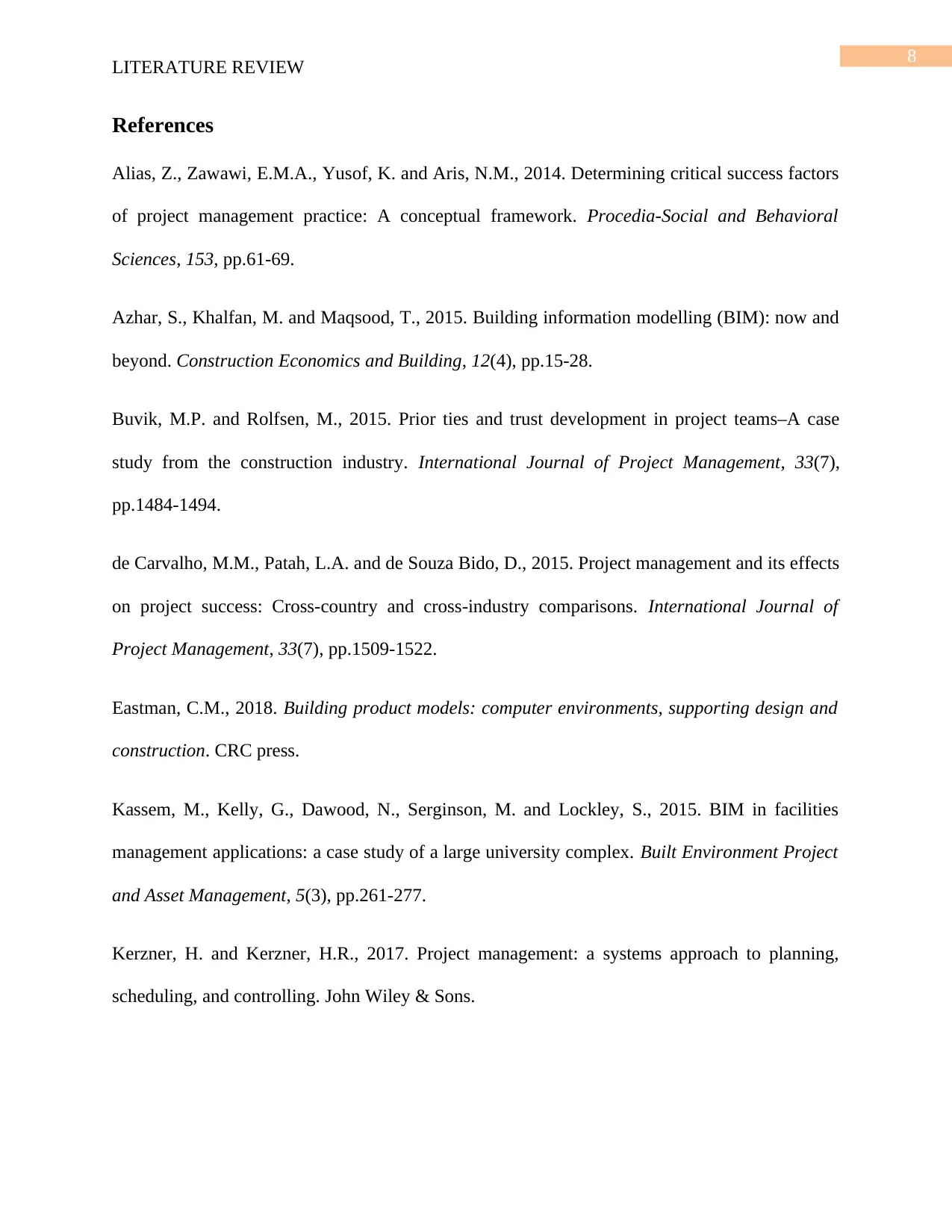
8
LITERATURE REVIEW
References
Alias, Z., Zawawi, E.M.A., Yusof, K. and Aris, N.M., 2014. Determining critical success factors
of project management practice: A conceptual framework. Procedia-Social and Behavioral
Sciences, 153, pp.61-69.
Azhar, S., Khalfan, M. and Maqsood, T., 2015. Building information modelling (BIM): now and
beyond. Construction Economics and Building, 12(4), pp.15-28.
Buvik, M.P. and Rolfsen, M., 2015. Prior ties and trust development in project teams–A case
study from the construction industry. International Journal of Project Management, 33(7),
pp.1484-1494.
de Carvalho, M.M., Patah, L.A. and de Souza Bido, D., 2015. Project management and its effects
on project success: Cross-country and cross-industry comparisons. International Journal of
Project Management, 33(7), pp.1509-1522.
Eastman, C.M., 2018. Building product models: computer environments, supporting design and
construction. CRC press.
Kassem, M., Kelly, G., Dawood, N., Serginson, M. and Lockley, S., 2015. BIM in facilities
management applications: a case study of a large university complex. Built Environment Project
and Asset Management, 5(3), pp.261-277.
Kerzner, H. and Kerzner, H.R., 2017. Project management: a systems approach to planning,
scheduling, and controlling. John Wiley & Sons.
LITERATURE REVIEW
References
Alias, Z., Zawawi, E.M.A., Yusof, K. and Aris, N.M., 2014. Determining critical success factors
of project management practice: A conceptual framework. Procedia-Social and Behavioral
Sciences, 153, pp.61-69.
Azhar, S., Khalfan, M. and Maqsood, T., 2015. Building information modelling (BIM): now and
beyond. Construction Economics and Building, 12(4), pp.15-28.
Buvik, M.P. and Rolfsen, M., 2015. Prior ties and trust development in project teams–A case
study from the construction industry. International Journal of Project Management, 33(7),
pp.1484-1494.
de Carvalho, M.M., Patah, L.A. and de Souza Bido, D., 2015. Project management and its effects
on project success: Cross-country and cross-industry comparisons. International Journal of
Project Management, 33(7), pp.1509-1522.
Eastman, C.M., 2018. Building product models: computer environments, supporting design and
construction. CRC press.
Kassem, M., Kelly, G., Dawood, N., Serginson, M. and Lockley, S., 2015. BIM in facilities
management applications: a case study of a large university complex. Built Environment Project
and Asset Management, 5(3), pp.261-277.
Kerzner, H. and Kerzner, H.R., 2017. Project management: a systems approach to planning,
scheduling, and controlling. John Wiley & Sons.
⊘ This is a preview!⊘
Do you want full access?
Subscribe today to unlock all pages.

Trusted by 1+ million students worldwide
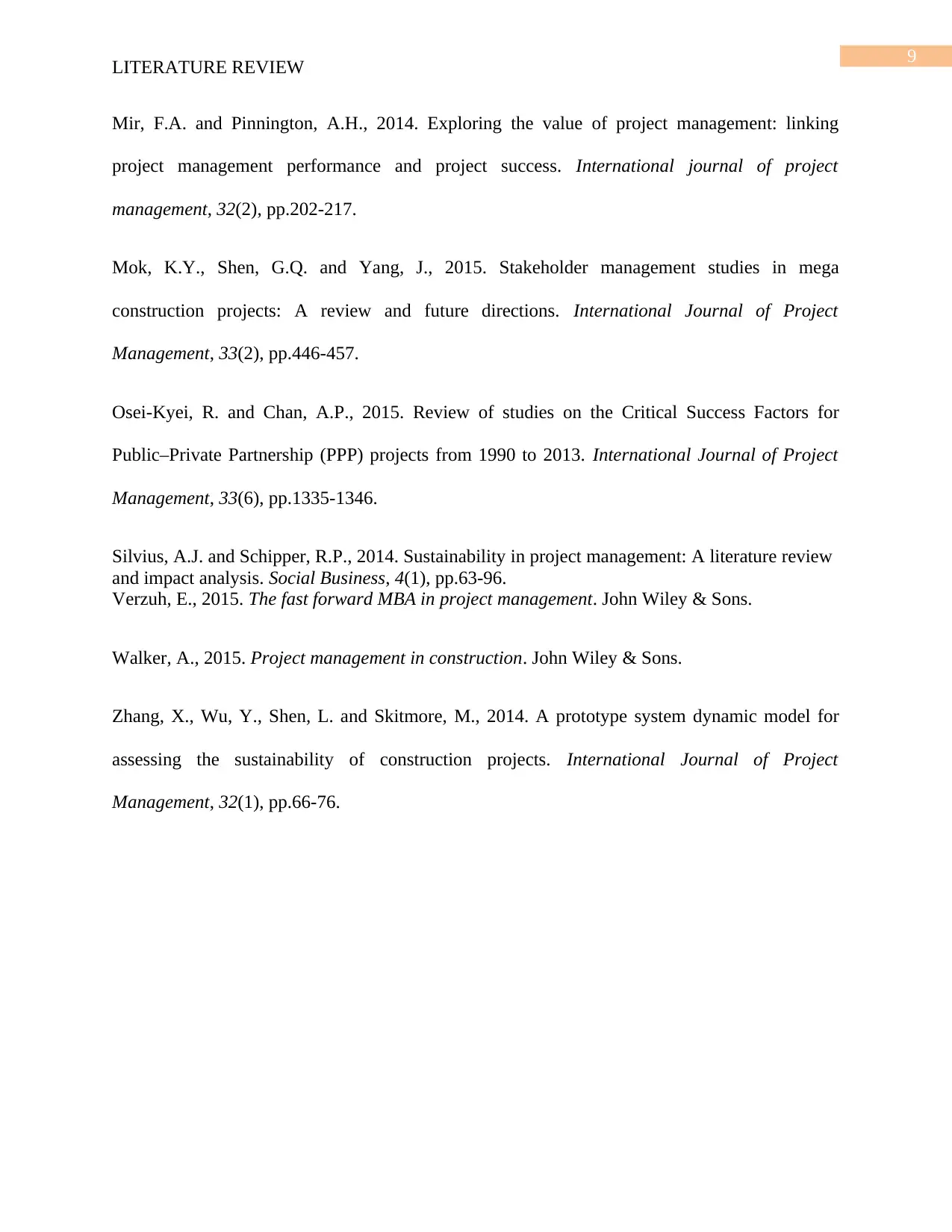
9
LITERATURE REVIEW
Mir, F.A. and Pinnington, A.H., 2014. Exploring the value of project management: linking
project management performance and project success. International journal of project
management, 32(2), pp.202-217.
Mok, K.Y., Shen, G.Q. and Yang, J., 2015. Stakeholder management studies in mega
construction projects: A review and future directions. International Journal of Project
Management, 33(2), pp.446-457.
Osei-Kyei, R. and Chan, A.P., 2015. Review of studies on the Critical Success Factors for
Public–Private Partnership (PPP) projects from 1990 to 2013. International Journal of Project
Management, 33(6), pp.1335-1346.
Silvius, A.J. and Schipper, R.P., 2014. Sustainability in project management: A literature review
and impact analysis. Social Business, 4(1), pp.63-96.
Verzuh, E., 2015. The fast forward MBA in project management. John Wiley & Sons.
Walker, A., 2015. Project management in construction. John Wiley & Sons.
Zhang, X., Wu, Y., Shen, L. and Skitmore, M., 2014. A prototype system dynamic model for
assessing the sustainability of construction projects. International Journal of Project
Management, 32(1), pp.66-76.
LITERATURE REVIEW
Mir, F.A. and Pinnington, A.H., 2014. Exploring the value of project management: linking
project management performance and project success. International journal of project
management, 32(2), pp.202-217.
Mok, K.Y., Shen, G.Q. and Yang, J., 2015. Stakeholder management studies in mega
construction projects: A review and future directions. International Journal of Project
Management, 33(2), pp.446-457.
Osei-Kyei, R. and Chan, A.P., 2015. Review of studies on the Critical Success Factors for
Public–Private Partnership (PPP) projects from 1990 to 2013. International Journal of Project
Management, 33(6), pp.1335-1346.
Silvius, A.J. and Schipper, R.P., 2014. Sustainability in project management: A literature review
and impact analysis. Social Business, 4(1), pp.63-96.
Verzuh, E., 2015. The fast forward MBA in project management. John Wiley & Sons.
Walker, A., 2015. Project management in construction. John Wiley & Sons.
Zhang, X., Wu, Y., Shen, L. and Skitmore, M., 2014. A prototype system dynamic model for
assessing the sustainability of construction projects. International Journal of Project
Management, 32(1), pp.66-76.
1 out of 10
Related Documents
Your All-in-One AI-Powered Toolkit for Academic Success.
+13062052269
info@desklib.com
Available 24*7 on WhatsApp / Email
![[object Object]](/_next/static/media/star-bottom.7253800d.svg)
Unlock your academic potential
Copyright © 2020–2025 A2Z Services. All Rights Reserved. Developed and managed by ZUCOL.




